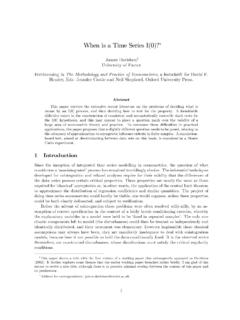Transcription of 0.1 Strictconvexityandconcavity - Exeter
1 BEE1020 Basic Mathematical EconomicsWeek 7, Lecture Tuesday , concavity. Sign Strict convexity and concavityIf we look again at the cost increases in Example 2 we notice that the cost increases arethemselves increasing:Q01234567TC110135170215270335 410495 TC25354555657585 2TC101010101010In other words, the increase of the increase (written as 2TC= ( TC)) is alwayspositive. Costs are accelerating, the more is already produced, the more costly it is tofurther increase production. Economists speak ofincreasing marginal costs, the costs ofproducing one unit more is higher when more is produced. Mathematicians speak here ofastrictly convex the graphs we see this as follows: The graph is upward-bowed. The tangents get steeper from left to right, , their slopes are , the marginal costsMC(Q) = 10Q+ 20 are increasing, not only positive, ifwe draw the graph of the marginal cost curve:100200300400500TC0 1 2 3 4 5 6 7 QThe total costs in Example 2020406080100MC1 2 3 4 5 6 7 QIncreasing marginal call a function with a graph which is upward-bowed (like a cup )strictlyconvex.
2 In contrast, a function with a downward-bowed graph (like acap ) is calledstrictly word strictly is used here to indicate that the graph isproperlycurvedand not, at least partly, a straight line. Correspondingly,a linear function isregarded as both convex and concave, but not as strictly convex or as strictly upward concave instead of strictly convex and downward concave instead of strictlyconcave . I have never seen these terminology in any other book. Hence I prefer to stick hence with theterminology your future teachers will understand. I guess the authors did not know the cave-rule .It is easy to memorize what concave is a opposed to convex because of the word cave appears in concave:con-caveExample 3 does not exhibit increasing marginal costs: The cost increases TCarefirst decreasing and then TC442088204480 2TC-24-120122436204060801001201401601802 00220240TC0 1 2 3 4 5 6 7 QExample 320406080100MC0 1 2 3 4 5 6 7QU-shaped marginal the graph of the total cost function this is reflected by thefact that the graph of thetotal function is first downward-bowed and then upward bowed.
3 The tangents are firstdecreasing and then increasing. We say that the total costs function isstrictly concavefor 0 Q 3 andstrictly convexfor 3 graph of the marginal cost curve is given above. For obvious reasons economistsspeak of aU-shapedmarginal cost , calculus can help to decide whether a function is convex or concave on aninterval. Since we have been looking here at differences of costs differences, we must nowuse thesecond derivativeof a function. This is simply the derivative of the derivative ofthe function. Newton usedy (x) to denote the second derivative of a function, Example 2 we haved2 TCdQ2=dMCdQ=d(10Q+ 20)dq= 10> Example 3 we haved2 TCdQ2=dMCdQ=d(6Q2 36Q+ 60)dq= 12Q 36 = 12 (Q 3)which is negative forQ <3 and positive forQ >3. This information allows us to deduceimmediately on which intervals the total cost functions areconcave or convex and where,correspondingly, marginal costs are increasing or result we can use here is:Theorem 1 The following statements are equivalent for a twice continuously differen-tiable function on an interval:a) The function is strictly convex on the ) Its first derivative is increasing on the intervalc) Its second derivative is nonnegative on the interval and never constantly zero onany 2 The following statements are equivalent for a twice continuously differen-tiable function on an interval.
4 A) The function is strictly concave on the ) Its first derivative is decreasing on the intervalc) Its second derivative is nonpositive on the interval and never constantly zero on :A function is convex (upward-bowed) if its tangents get steeper fromleft to right. The latter means that its first derivative is increasing and hence positivelysloped. Thus convex function corresponds to increasing first derivative and the latter topositive second derivative. Correspondingly, concave (downward-bowed) functions havedecreasing first derivatives and negative second diagramsRoughly speaking: A function is increasing (decreasing) where its first derivative is posi-tive (negative).A function is strictly convex (strictly concave) where its second derivative is positive(negative).In order to apply this to a polynomial functiony=f(x) we have to solve inequalitiesof the typef (x)>0 andf (x)>0forx.
5 In general, solving inequalities is messy and prone to errors. Consider, for instance,f(x) =(x2+ 1)x >0.(1)3We may be tempted to divide byx, as we would do with an algebraic equation, to obtainx2+ 1>0(2)which is true for allxsincex2is non-negative. We may conclude thatf(x)>0 for allx = 0. (Forx= 0 we havef(x) = 0.)However, this reasoning is wrong because ifxis a negative number then division byxchanges the sign on the left-hand side of (1). So, ifx <0 thenx2+ 1 must also benegative to havef(x)>0, , when we divide by negativexthe inequality reverts signand we obtainx2+ 1<0(3)instead of (2). Inequality 3 is not satisfied for anyx. Putting together our results forpositive and negativexwe see thatf(x)>0 if and only ifx > is a much simpler way to get to this result which avoids any algebraic manip-ulation of inequalities:f(x) is the product of the two factorsx2+ 1 andx.
6 In order forf(x) to be positive either both factors must be positive or both must be negative. Sincex2+ 1 is always positive,xmust be method of sign diagrams uses this simple type of consideration. It requires us,however, to find a nice factorization of the relevant polynomialf, which, in turn,requires us to find its this lecture we will first discuss1. How sign diagrams can be used to decide where a polynomial is positive- or How we can find therootsof a polynomial ( , the solutions to the equationf(x) =0) in special How roots help us to factorize a we demonstrate how these methods can be used to determine the importantqualitative features of a polynomial function without drawing tables or evaluating thepolynomial at many points. We present this information withthe aid of asummary Sign diagrams for polynomial functionsConsider the polynomialP(x) = (x+ 5) (x 2)2( 2x+ 6) = 2x4+ 4x3+ 38x2 136x+ 120 Obviously, the roots arex= 5,x= 2 andx= 3.
7 To find out whereP(x) is positiveor negative we draw asign diagram. This is a table with one column for each root, onecolumn for each interval between the roots, one column for the numbers to the left of allroots and one column for the numbers to the right of all is one row for each4factor of the polynomial and a final row for the polynomial itself. The entries in the tableare +, or 0. For each factor it is easy to decide where it is positive,negative or zeroand hence to make the corresponding entry in the table. Once we know the signs of allfactors in an interval, we know the sign off(x) in this interval. In our examplex < 5x= 5 5< x <2x= 22< x <3x= 33< xx+ 5 0+++++x 2 0+++x 2 0+++ 2x+ 6+++++0 f(x) 0+0+0 The signs for the factor 2x+6 are obtained as follows: A linear factor changes sign onlyonce, namely at the root which is herex= 3 (since 2x+6 = 0 yields 6 = 2x).
8 Forx= 4we have 2x+6 = 2<0. Therefore 2x+1 is positive to the right ofx= 3 and it mustbe positive to the left of the root. (Check: Forx= 2 we have indeed 2x+ 6 = 2>0.)Forx < 5 and for 3< xthe polynomialf(x) is negative because it has an oddnumber of negative factors. For 5< x <2 and for 2< x <3 the polynomial is positivebecause it has an even number of negative look at the graph ofy=f(x) confirms our 2 3 3 Construct the sign diagram of the polynomialf(x) = 3 (x+ 1)3(x 1)2(x 4) = 3x6+ 9x5+ 18x4 18x3 27x2+ 9x+ 1252 Finding roots of a polynomialThe hard work is to find the roots of a polynomial and to factorize it. Except for linear orquadratic polynomials, we restrict ourselves to methods which work only in special , we start with a very deep and general result in The fundamental theorem of algebraGauss (1777 1855):Every non-constant polynomial can be written as a product oflinear factors and quadratic factors with no real a consequence, the roots of a polynomial are precisely theroots of its linear 1 Solution 1x4 1 = (x2+ 1) (x2 1) = (x2+ 1) (x+ 1) (x 1) using twicethe always important formulaa2 b2= (a+b) (a b).
9 Here the quadratic factorx2+ 1has no real 2x8 1 = (x4+ 1) (x4 1) = (x4+ 1) (x2+ 1) (x+ 1) (x 1) where the poly-nomialx4+1 has no real roots and must hence be the product of two quadratic polynomialswith no real roots. This factorization is harder to find, however(x2+ 2x+ 1)(x2 2x+ 1)=x4+ 2x3+x2 2x3 2x2 2xx2+ 2x+1=x4+1sox8 1 =(x2+ 2x+ 1)(x2 2x+ 1)(x2+ 1) (x+ 1) (x 1) where the quadraticfactors are easily seen to have no real Roots of linear polynomialsThe root of a linear polynomialf(x) =ax+bwitha = 0 isx0= Roots of quadratic polynomialsThe roots of a quadratic polynomialf(x) =ax2+bx+cwitha = 0 are given byx1/2= b b2 thediscriminantb2 4cis negative there are no real term real roots is used to emphasie that we do not consider imaginary roots like 6. Onecan actually calculate with such numbers in a meaningful way.
10 However, they do not represent points onthe number line are hence difficult to interpret ,x2are the roots of a quadratic polynomial. Then one has theformulas ofVieta(1540 1603)x1+x2= baandx1x2=caand the factorization isf(x) =a(x x1) (x x2)sincea(x x1) (x x2) =a(x2 (x1+x2)x+x1x2)=ax2+bx+cby Vieta s useful information on quadratic function:The graph of a quadratic function is called >0 the function is strictlyconvex with a unique minimum atx = b2a. Ifa <0 the function is strictly concavewith a unique maximum atx = b2a. The parabola is mirror-symmetric to the verticalline through the maximum/minimum (x ,0), , one hasf(z+x ) =f( z+x ) for allz. The minimum or maximum is always in the middle between the two rootsx1,x2whenthe two exist becausex =x1+x22by Vieta s -2 -1 0 1 2 3 4 5xa convex parabola-12-10-8-6-4-20-3 -2 -11 2 3 4 5xa concave parabolaProblem 4 Suppose the government imposes an excise taxt, wheretis the percentageof the price charged to consumersa) What is tax revenue when the tax ist= 0%?







